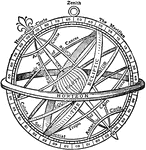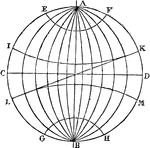Clipart tagged: ‘Equator’

Armilla
"Armillary Sphere, an instrument used in astronomy. In its simplest form, consisting of a ring fixed…

Earth Divisions
"The Earth, whose diameter is 7,912 miles, is represented by the globe, or sphere. The straight line…
Spring Equinox and Autumn Equinox
"Relative positions of the earth and the sun on March 21 (spring equinox) and September 21 (autumn equinox)…

Longitude
"Let this figure represent the Earth, N being the north pole, S the south pole, and E W the equator.…

Pole Depression
"Two hoops of thin iron are placed upon an axis which passes through their poles. The two ends of each…

Summer Solstice
"Relative positions of the earth and the sun on June 21, the summer solstice. Summer and long days north…

Winter Solstice
"Relative positions of the earth and the sun on December 21, the winter solstice. Winter and short days…